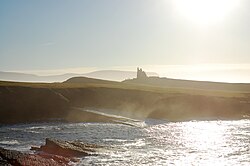Mullaghmore, County Sligo
|
Mullaghmore An Mullach Mór
|
|
|---|---|
| Village | |

A view of Mullaghmore
|
|
| Location in Ireland | |
| Coordinates: 54°27′59″N 8°26′55″W / 54.4664°N 8.4486°WCoordinates: 54°27′59″N 8°26′55″W / 54.4664°N 8.4486°W | |
| Country | Ireland |
| Province | Connacht |
| County | County Sligo |
| Elevation | 1 m (3 ft) |
| Population (2006) | |
| • Total | 147 |
| Irish Grid Reference | G709577 |
Mullaghmore (Irish: An Mullach Mór, meaning "the great summit") is a village on the Mullaghmore peninsula in County Sligo, Ireland. It is a noted holiday destination, characterised by ocean views and a skyline dominated by the monolithic shape of Ben Bulben mountain. It is in the barony of Carbury and parish of Ahamlish.
From the 17th to the 19th century it was part of the large estate belonging to the Temple family in north Sligo. The land, some 12,000 acres, was granted to Sir John Temple, 1st Viscount Palmerston and Master of the Rolls in Dublin. The 3rd Viscount, Henry John Temple, better known as Lord Palmerston, began the building of the castle of Classiebawn, a baronial style house standing on the peninsula. He also built the stone-walled harbour in the village, which was designed by the marine engineer Alexander Nimmo. It was built between 1822 and 1841.
The Temples were mostly absentee landlords, with the estate being run initially by middlemen, and later by land agents, such as Stewart and Kincaid, a Dublin firm with offices in Sligo. These agents, in their attempts to make the estates profitable, oversaw the "assisted emigration" that took place on the Palmerston and adjacent Gore Booth (Lissadell) estate that began before the famine and continued until at least the 1860s.
Thus, in May 1862, a Sligo newspaper reported: "In accordance with a custom of some years standing, about sixty persons have been selected for emigration from the Parish of Ahamlish ... whose passages and outfit has been provided by his Lordship. They consist of twenty-four young girls, and twenty young men ... [and] families who were wholly unable to support themselves ... who had asked the favour of being sent out ..... The emigrants took their passages ... this day, for Liverpool, en route for America."
Classiebawn was a favoured holiday retreat of Admiral of the Fleet Louis Mountbatten, 1st Earl Mountbatten of Burma, the last Viceroy of India, who had inherited Classiebawn Castle. It was off the Mullaghmore coast in August 1979 that Lord Mountbatten, along with The Dowager Baroness Brabourne and County Fermanagh teenager Paul Maxwell, were killed by a bomb planted by the Provisional IRA.
...
Wikipedia

